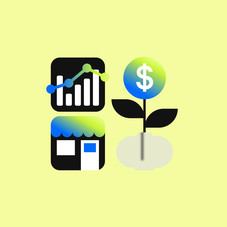Table of contents
This article was updated to reflect changes from the Paycheck Protection Program Flexibility Act which President Trump signed into law on June 3, 2020. This act amends some provisions of the PPP program. Since this article was written, an additional round of the PPP program was opened to small business owners. Please be sure to refer to the SBA website for the most up-to-date guidance on PPP forgiveness.
This article is only for educational purposes and does not constitute legal, financial, or tax advice. Make sure you consult a professional regarding your unique business needs.
The Paycheck Protection Program (PPP) is one form of financial assistance many businesses have sought out to help them stay afloat during this time. PPP is a loan aimed at helping businesses maintain their payroll. One of the reasons the PPP is so appealing is that the loan can be fully forgiven. That means recipients don’t have to pay it back, which is called PPP loan forgiveness.
For those of you that received a PPP loan, we’re breaking down what you can do next to set yourself up to get it converted to a grant when the time comes. And if you didn’t get a PPP loan, we’ll go over some other options for financial assistance that are still available.
PPP loan forgiveness rules: What to do after getting your PPP loan
1. Spend it on approved expenses in the right time period.
The PPP loan is structured specifically to help small businesses keep their workforce employed. For that reason, the U.S. Small Business Administration deems eligible payroll expenses to be forgivable for up to 100% of the loan and eligible non-payroll expenses (mortgage interest, rent, and utilities) to be forgivable for up to 40% of the loan (previously 25% under the old forgiveness rules).
For your loan to qualify for full forgiveness, small business borrowers must spend at minimum 60% of the PPP funds on payroll (previously 75% under the old forgiveness rules) and the remainder of the funds need to be spent on eligible non-payroll expenses (mortgage interest, rent, utilities, operation costs, property damage caused by public disturbances in 2020, supplier costs, and worker protection costs). If any part of the PPP funds are used for any other expense, that amount won’t be forgiven, however you can qualify for partially forgivable amounts if you spend your PPP funds on any of the aforementioned categories.
The period of time during which these expenses must take place is called the “covered period,” which is between eight weeks to 24 weeks following the day the loan is disbursed.
In addition to spending 60% of your PPP loan on payroll, if your loan is greater than $50,000, you must also maintain your employee headcount during the covered period. Wages should also be maintained during this same period and, to qualify for forgiveness, can’t be reduced by more than 25% for employees that make less than $100,000 annually.
If you furloughed or laid off any of your employees, that’s okay. In order to maintain headcount to get your loan fully forgiven, you will have to rehire employees and restore their compensation to at least 75% of what it was by the end of your covered period. If you don’t do this, your loan forgiveness will be reduced (if your loan is greater than $50,000). However, you are still eligible for forgiveness if you were not able to restore your full workforce because:
- You extended good faith written offers to employees to be rehired and those employees turned down the employment.
- During the covered period, any of your employees were fired for cause, voluntarily resigned, or voluntarily requested and received a reduction of their hours.
- You cannot find qualified employees.
- You are not able to restore business operations to February 15, 2020 levels due to COVID-19 related operating restrictions.
Payroll, for the purposes of PPP loan forgiveness, can’t include payments to independent contractors. However, there are other payments that can be included in forgivable payroll costs in addition to cash compensation consisting of salary, wages, and commissions (under $100,000 annually per employee):
- If you are a sole proprietorship or independent contractor without employees that received a PPP loan, you can include net earnings from your business as long as they were listed on Line 31 your 2019 Form 1040, Schedule C. These are capped at $20,833 per owner. (Note: new rules regarding the use of Line 7, Gross Income on your Form 1040, Schedule may change this rule).
- Employers that pay tipped employees can include any wages you pay to your employees to cover tips they would have otherwise earned.
- Paid leave outside of Families First Coronavirus Relief Act (FFRCA) credits. If you pay for sick leave or family leave using FFRCA credits, those funds will not be forgiven.
- Payments to employee health insurance and retirement benefits.
- State and local payroll taxes that were paid by the employer (for example, state unemployment insurance contributions).
- Severance payments.
2. Keep your spending well documented.
You’ll want to make it easy on yourself when it comes time to show how you spent your PPP loan. The best way to do this is to keep very comprehensive records. One way to streamline the process of documenting your expenses is to separate your business and personal finances. However, this isn’t a prerequisite for loan forgiveness.
To start your documentation for the purpose of PPP loan forgiveness, record the amount, date, and lender information in your books as soon as your PPP funds are deposited into your account.
Then track the way you spend your PPP funds over the eight to 24 weeks following your receipt of the funds. Be sure for each expense to document the date, vendor information, and category as it pertains to PPP forgiveness approved expenses (e.g., payroll, utilities, etc.). This will also help you understand if you’re spending the loan in a way that sets you up to be forgiven. If your loan is less than $150,000, you will not be required to submit supporting documentation with your forgiveness application. However, all PPP borrowers must retain their PPP loan documentation for up to four years following the loan.
3. Gather reports and documents.
In addition to tracking your expenses, you’ll need to collect and organize receipts and reports to verify your spending. Gather documentation that shows your rent or mortgage interest payments, utility bills, and payroll reports.
Additionally, stay up to date with your lender on what they will require from you when it comes time for loan forgiveness. If there are any additional records they will need from you, you’ll want to collect them as part of this practice.
For second draw PPP loans, you will need to demonstrate that you experienced at least a 25% decrease in revenue in a quarter in 2020 relative to a quarter in 2019 or during the year 2020 as compared to 2019.
4. Prepare and submit your PPP loan forgiveness application.
The SBA released the PPP Loan Forgiveness Application. Be sure to submit it in the preferred format of your lender.
Lenders have 60 days from the date that you submit your loan forgiveness application form to notify you of whether or not your loan has been forgiven (or which portion of your loan is being forgiven). Forgiven loans will be excluded from your gross income when it comes to filing your income taxes. If your loan, or a portion of your loan, isn’t forgiven, you will have to make a plan with your lender to repay the loan with 1% interest.
Please note that some of the following options can be layered with a PPP loan and some cannot, so be sure to verify before exploring these options after accepting a PPP loan.
What to do if you didn’t receive a PPP loan
If you didn’t receive a PPP loan, there are other options.
- Economic Injury Disaster Loans (EIDLs) from the SBA: Typically, EIDLs are for businesses that need financial help due to a natural disaster. As of early March, eligibility for these loans has been extended to businesses that are affected by COVID-19. The CARES Act expands this program and makes it easier to apply.
- Employee Retention Credit: This is a refundable tax credit available to eligible employees, equal to 50% of wages of up to $10,000 for certain employees, meaning the maximum credit per employee is $5,000. This credit applies to wages paid after March 12, 2020, and before January 1, 2021. Your business is eligible for this credit if your business operations were fully or partially suspended due to COVID-19 or if your business experiences a more than 50% decline in quarterly gross receipts. You can either apply for this credit using the Form 7200, Advance Payment of Employer Credits Due to COVID-19 or apply the credit to your Q2 2020 Form 941.
- Deferred payroll taxes: Usually employers would pay 6.2% of Social Security tax on their employees’ wages. For payments owed in 2020, businesses and self-employed individuals can now defer these payments over the next two years. You must pay 50% by the end of 2021 and the remaining 50% by the end of 2022. Note that you can’t defer these payments if you’ve had a Paycheck Protection loan forgiven.
- State and local government programs: Some states and cities have set up financial assistance programs, loans, and grants for small businesses in their jurisdictions. Check in with your local chamber of commerce or see Square’s article on financial relief for small businesses for more information.
- Private programs: Many nonprofit organizations, banks, and corporations have rolled out financial relief programs as well. You can find programs specific to your business needs in Square’s financial relief article.
The guidelines for PPP loan forgiveness are subject to change, as are the opportunities for other kinds of financial assistance outside the PPP loan. We’re doing our best to keep you updated but be sure to continue to check in with your lender and your local chamber of commerce for more information about the PPP loan forgiveness rules.
![]()











